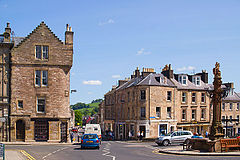Jedburgh
|
Jedburgh Scottish Gaelic Deadard |
||
|---|---|---|
| Jedburgh Market Cross | ||
| Coordinates | 55 ° 29 ′ N , 2 ° 33 ′ W | |
|
|
||
| Residents | 4030 2011 census | |
| administration | ||
| Post town | JEDBURGH | |
| ZIP code section | TD8 | |
| prefix | 01835 | |
| Part of the country | Scotland | |
| Council area | Scottish Borders | |
| British Parliament | Berwickshire, Roxburgh and Selkirk | |
| Scottish Parliament | Ettrick, Roxburgh and Berwickshire | |
Jedburgh ( pronunciation : [ 'dʒɛdbərə ], Scottish : Jeddart / Jethart , Scottish Gaelic : Deadard ) is a town in the Scottish Borders and was formerly a Royal Burgh (town with a royal statute - Royal Charter ) in the traditional county of Roxburghshire . The ruins of the Augustinian monastery Jedburgh Abbey and the former fortress Jedburgh Castle dominate the cityscape.
Jedburgh is located on Jed Water , a tributary of the River Teviot . The city has no rail connection, but is integrated into the British trunk road network via the A68 , where it is the next major settlement north of Carter Bar, about 17 km away on the Scottish-English border.
story
Bishop Ecgred von Lindisfarne built a church here as early as the 9th century, and under the rule of King David I of Scotland it became a priory between 1118 and 1138 . The Augustinian monks came from Beauvais in France. The abbey was founded in 1147, but was destroyed and never rebuilt during the border wars between England and Scotland in the 16th century. King Malcolm IV of Scotland died here in 1165 as a result of an excessive religious fast.
King David I also built the castle, which in 1174 was one of the five castles that had to be ceded to the English. In the meantime again in Scottish possession, it was also royal seat a few times, but repeatedly fell to the English until it was demolished in 1409 as the last English stronghold in Scotland. Throughout history, the fortress has always been a focus of mutual border crossings and raids.
In 1258 the negotiations between Alexander III took place here . of Scotland and Henry III. held by England over the succession dispute for the Scottish throne. Alexander III married in 1285 in Jedburgh Abbey. In 1566, Queen Maria Stuart lived for a short time in a house in the city that is now a museum.
Charles Edward Stuart ("Bonnie Prince Charlie") led his Jacobite army from here to England in 1745 and also stayed in the city. The castle was converted into a prison in 1823. The prison was abandoned in 1868 and restored in the style of 1820 in 1964. For a while it served as a hostel for the Scottish Youth Hostels Association , then the Jedburgh Castle Jail and Museum opened here .
Personalities
The astronomer and mathematician Mary Somerville (1780–1872) was born in Jedburgh, as was the physicist David Brewster (1781–1868), the inventor of the kaleidoscope and the dioptric stereoscope .
The writer James Thomson , the copywriter of “ Rule, Britannia! “ , Was born in a neighboring town and went to school in Jedburgh.
Sports
Jedburgh is home to one of the oldest and most well-known rugby union teams , Jed-Forest RFC , as well as Jed Legion FC football club . The local cricket club was dissolved around 1980. Jedburgh is the only town in the Scottish Borders to have a dry ski slope (plastic ski slope ). Canoeing is possible in Jed Water, and the Jedburgh Grammar School has a climbing garden.
Jethart Snails
The Jethart Snails are a local mint-flavored sweet that is said to have been brought here by French prisoners of war from the Napoleonic Wars . The Snails are only offered in the Brown Sugar Coffee Shop .
Web links
- Jedburgh homepage (accessed May 5, 2012)
- Jed-Forest RFC (accessed May 5, 2012)
- Attractions (accessed May 5, 2012)



